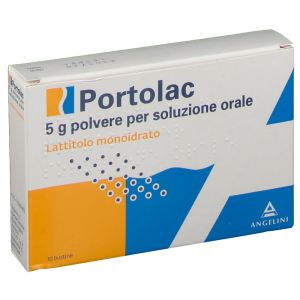Ship in Europe, Find out rates!
Language
Angelini Portolac 5g Powder For Oral Solution 10 Sachets

Regular Price
€7.40
Special Price
€5.58
-25%
Save: €1.82
In stock
Recent lowest price:
€5.58
- box Delivery in Italy in 24/48 and free returns
- star3.000+ positive reviews
- dropboxOver 60,000 products in the catalog
Manufacturer
ANGELINI
SKU
026814172
Active principle
LATTITOLO MONOIDRATO
NAME
PORTOLAC
PHARMACOTHERAPEUTIC CATEGORY
Constipation medications.
ACTIVE PRINCIPLES
Lactitol monohydrate.
EXCIPIENTS
Powder for oral solution: none. Syrup: benzoic acid; sodium hydroxide; purified water.
INDICATIONS
Short-term treatment of occasional constipation.
CONTRAINDICATIONS / SECONDARY EFFECT
Hypersensitivity 'to lactitol or to any of the excipients; the drug produces its effect in the colon and is therefore contraindicated in all cases in which intestinal transit is not ensured (intestinal obstruction, etc.); the medicine should not be used in case of any symptoms or suspicion of organic lesion of the digestive tract and in case of any abdominal pain of unknown origin or rectal bleeding; fecal impaction must be treated in another way before using laxatives; breastfed infants and infants with hereditary autosomal recessive fructose intolerance; the drug is contraindicated in galactosemia; the incomplete metabolism of lactitol can lead to the development of fructosemia and galactosemia and their sequelae; pre-existing water-electrolyte imbalance.
DOSAGE
>> Adults. Powder for oral solution: 10-15 g per day, equal to 2-3 scoops of 5 g powder for oral solution, 2-3 sachets of 5 g or 1 sachet of 10 g, in a single administration, preferably in the evening before bedtime. Syrup: 15-30 ml syrup per day (corresponding to 1-2 measuring spoons filled up to the 15 ml mark) in a single administration, preferably in the evening before going to bed. >> Children Powder for oral solution: the medicine should be taken in a single administration, in the morning with breakfast from 2 to 6 years, 5 g per day, equal to a 5 g measuring spoon of powder for oral solution or a sachet from 5 g; over 6 years, 5-10 g per day, equal to 1-2 scoops of 5 g of powder for oral solution, 1-2 sachets of 5 g or 1 sachet of 10 g. Syrup: the syrup product should be taken in a single dose, in the morning with breakfast: from 2 to 6 years, 10 ml per day (equal to 1 measuring cup filled up to the 10 ml mark); over 6 years, 10-15 ml per day (equal to 1 measuring cup filled up to the 10 ml or 15 ml mark). >> Infants. Powder for oral solution: on average 1-2 g per day, equal to 1-2 scoops of 1 g of powder for oral solution. Syrup: on average 5 ml of syrup per day (equal to 1 measuring cup filled up to the 5 ml mark). In general, the optimal clinical response can be achieved with dosage adjustments of 5 g of powder for oral solution per day (more or less) in adults (equal to 1 scoop of syrup filled to the 7.5 ml mark. ) and 1 g of powder for oral solution per day in pediatric age. The medicine in the powder form for oral solution should be dissolved in water or other drinks (milk, tea, coffee, fruit juices) or added to other foods such as yogurt, cooked fruit, etc. The correct dose is the minimum sufficient to produce an easy evacuation of soft faeces. It is advisable to initially use the minimum expected doses. When necessary, the dose can then be increased, but without ever exceeding the maximum indicated. Laxatives should be used as infrequently as possible and for no more than seven days. Use for longer periods of time requires a doctor's prescription after adequate evaluation of the individual case. Ingest together with an adequate quantity of water (a large glass). A diet rich in liquids favors the effect of the medicine.
STORAGE
Powder for oral solution 5 g - 10 g: store in the original package to protect the medicine from moisture. Powder for oral solution 200 g: do not store above 25 degrees C. Store in the original package to protect from moisture. Syrup: this medicine does not require any special storage conditions.
WARNINGS
Avoid prolonged use of laxatives without interruption. All cases of chronic constipation should first be treated with a diet rich in fiber, sufficient fluid intake or physical activity. To avoid disturbance of the electrolyte balance caused by an overdose diarrhea, it is necessary to try to determine the optimal dosage at the beginning of the treatment to achieve one bowel per day in patients with constipation. Elderly or debilitated patients on long-term treatment with the drug should regularly monitor their serum electrolytes. Before starting treatment, a pre-existing water-electrolyte imbalance must be corrected. Following treatment, hydrogen can accumulate in the intestine. Patients who need to undergo electrocautery procedures must therefore perform a thorough intestinal cleansing with non-fermentable solution. Patients who complain of nausea should be advised to take the medicine with meals. The drug is not recommended in case of ileostomy or colostomy. Infants and children: the product should only be used if recommended. Patients with rare hereditary problems of fructose intolerance, galactose intolerance, galactosemia, or glucose-galactose malabsorption should not take this medicine. In the presence of intestinal meteorism, start treatment with the minimum doses indicated, gradually increasing them according to the effect obtained. The drug has no potecaryogen. The abuse of laxatives (frequent or prolonged use or with excessive doses) can cause persistent diarrhea with consequent loss of water, mineral salts (especially potassium) and other essential nutritional factors. In the most severe cases the onset of dehydration or hypokalemia is possible which can cause cardiac or neuromuscular dysfunctions, especially in the case of simultaneous treatment with cardiac glycosides, diuretics or corticosteroids. The abuse of laxatives, especially contact laxatives (stimulant laxatives), can cause addiction (and, therefore, possible need to gradually increase the dosage), chronic constipation and loss of normal intestinal functions (intestinal atony). Treatment of chronic or recurrent constipation always requires medical intervention for diagnosis, prescription of drugs and surveillance during therapy. Consult your doctor when the need for the laxative derives from a sudden change in previous bowel habits (frequency and characteristics of bowel movements) which lasted for more than two weeks or when the use of the laxative fails to produce effects. Pay attention to the elderly or in poor health before using the medicine.
INTERACTIONS
Since antacids and neomycin can neutralize the acidifying effect of lactitol on faeces, they should not be administered concomitantly with lactitol in cirrhotic patients with hepatic encephalopathy; however, both substances do not alter the laxative effect in patients with constipation. Like all laxatives, the drug can increase potassium loss caused by other drugs (e.g. thiazo-diuretics, corticosteroids, carbenoxolone, amphotericin B). Potassium deficiency may increase the risk of toxic effects of cardioglycosides in patients receiving concomitant therapy. Lactitol has a negligible caloric value (2 kcal / g or 8.5 kJ / g) and has no effect on insulin or blood glucose levels and can therefore be administered to diabetic patients. In case of intestinal dysmicrobism, it should be borne in mind that broad-spectrum antibacterial agents and antacids, administered orally simultaneously with lactitol, may decrease the effects exerted by the product on the intestinal microflora. Laxatives can reduce the time spent in the intestine, and therefore the absorption, of other drugs administered simultaneously orally. Therefore, avoid ingesting laxatives and other drugs at the same time: after taking a medicine, leave an interval of at least 2 hours before taking the laxative.
SIDE EFFECTS
At the beginning of the treatment, the medicine can 'cause abdominal discomfort, mainly flatulence and rarely abdominal pain or sometimes abdominal distension. These effects tend to diminish or disappear after a few days of taking the drug regularly. Due to inter-individual variability, some patients may experience diarrhea at the recommended dosage. This can be resolved by reducing the dosage. The adverse reactions listed below were observed in clinical studies and confirmed by spontaneous reports. The MedDRA system / organ classification is used with the following frequencies: very common (> = 1/10), common (> = 1/100 to <1/10), uncommon (> = 1 / 1,000 to <1/100 ), rare (> = 1 / 10,000, <1 / 1,000) or very rare (<1 / 10,000). Gastrointestinal disorders. Rare: abdominal pain, abdominal distension, diarrhea, flatulence, vomiting; very rare: nausea, abnormal gastrointestinal sounds, anal itching. The reporting of suspected adverse reactions that occur after the authorization of the drug is important, as it allows continuous monitoring of the benefit / risk ratio of the drug.
PREGNANCY AND BREASTFEEDING
Data on the use of the medicinal product in pregnant women do not exist or are limited in number. Animal studies do not indicate direct or indirect harmful effects with respect to reproductive toxicity. As for all medicines, it is recommended to use the drug in the first quarter of pregnancy, only in case of absolute necessity. There is insufficient information on the excretion of lactitol in breast milk. Lactitol is not expected to cause effects on newborns / infants, since systemic exposure to lactitol of lactating women is negligible.
PORTOLAC
PHARMACOTHERAPEUTIC CATEGORY
Constipation medications.
ACTIVE PRINCIPLES
Lactitol monohydrate.
EXCIPIENTS
Powder for oral solution: none. Syrup: benzoic acid; sodium hydroxide; purified water.
INDICATIONS
Short-term treatment of occasional constipation.
CONTRAINDICATIONS / SECONDARY EFFECT
Hypersensitivity 'to lactitol or to any of the excipients; the drug produces its effect in the colon and is therefore contraindicated in all cases in which intestinal transit is not ensured (intestinal obstruction, etc.); the medicine should not be used in case of any symptoms or suspicion of organic lesion of the digestive tract and in case of any abdominal pain of unknown origin or rectal bleeding; fecal impaction must be treated in another way before using laxatives; breastfed infants and infants with hereditary autosomal recessive fructose intolerance; the drug is contraindicated in galactosemia; the incomplete metabolism of lactitol can lead to the development of fructosemia and galactosemia and their sequelae; pre-existing water-electrolyte imbalance.
DOSAGE
>> Adults. Powder for oral solution: 10-15 g per day, equal to 2-3 scoops of 5 g powder for oral solution, 2-3 sachets of 5 g or 1 sachet of 10 g, in a single administration, preferably in the evening before bedtime. Syrup: 15-30 ml syrup per day (corresponding to 1-2 measuring spoons filled up to the 15 ml mark) in a single administration, preferably in the evening before going to bed. >> Children Powder for oral solution: the medicine should be taken in a single administration, in the morning with breakfast from 2 to 6 years, 5 g per day, equal to a 5 g measuring spoon of powder for oral solution or a sachet from 5 g; over 6 years, 5-10 g per day, equal to 1-2 scoops of 5 g of powder for oral solution, 1-2 sachets of 5 g or 1 sachet of 10 g. Syrup: the syrup product should be taken in a single dose, in the morning with breakfast: from 2 to 6 years, 10 ml per day (equal to 1 measuring cup filled up to the 10 ml mark); over 6 years, 10-15 ml per day (equal to 1 measuring cup filled up to the 10 ml or 15 ml mark). >> Infants. Powder for oral solution: on average 1-2 g per day, equal to 1-2 scoops of 1 g of powder for oral solution. Syrup: on average 5 ml of syrup per day (equal to 1 measuring cup filled up to the 5 ml mark). In general, the optimal clinical response can be achieved with dosage adjustments of 5 g of powder for oral solution per day (more or less) in adults (equal to 1 scoop of syrup filled to the 7.5 ml mark. ) and 1 g of powder for oral solution per day in pediatric age. The medicine in the powder form for oral solution should be dissolved in water or other drinks (milk, tea, coffee, fruit juices) or added to other foods such as yogurt, cooked fruit, etc. The correct dose is the minimum sufficient to produce an easy evacuation of soft faeces. It is advisable to initially use the minimum expected doses. When necessary, the dose can then be increased, but without ever exceeding the maximum indicated. Laxatives should be used as infrequently as possible and for no more than seven days. Use for longer periods of time requires a doctor's prescription after adequate evaluation of the individual case. Ingest together with an adequate quantity of water (a large glass). A diet rich in liquids favors the effect of the medicine.
STORAGE
Powder for oral solution 5 g - 10 g: store in the original package to protect the medicine from moisture. Powder for oral solution 200 g: do not store above 25 degrees C. Store in the original package to protect from moisture. Syrup: this medicine does not require any special storage conditions.
WARNINGS
Avoid prolonged use of laxatives without interruption. All cases of chronic constipation should first be treated with a diet rich in fiber, sufficient fluid intake or physical activity. To avoid disturbance of the electrolyte balance caused by an overdose diarrhea, it is necessary to try to determine the optimal dosage at the beginning of the treatment to achieve one bowel per day in patients with constipation. Elderly or debilitated patients on long-term treatment with the drug should regularly monitor their serum electrolytes. Before starting treatment, a pre-existing water-electrolyte imbalance must be corrected. Following treatment, hydrogen can accumulate in the intestine. Patients who need to undergo electrocautery procedures must therefore perform a thorough intestinal cleansing with non-fermentable solution. Patients who complain of nausea should be advised to take the medicine with meals. The drug is not recommended in case of ileostomy or colostomy. Infants and children: the product should only be used if recommended. Patients with rare hereditary problems of fructose intolerance, galactose intolerance, galactosemia, or glucose-galactose malabsorption should not take this medicine. In the presence of intestinal meteorism, start treatment with the minimum doses indicated, gradually increasing them according to the effect obtained. The drug has no potecaryogen. The abuse of laxatives (frequent or prolonged use or with excessive doses) can cause persistent diarrhea with consequent loss of water, mineral salts (especially potassium) and other essential nutritional factors. In the most severe cases the onset of dehydration or hypokalemia is possible which can cause cardiac or neuromuscular dysfunctions, especially in the case of simultaneous treatment with cardiac glycosides, diuretics or corticosteroids. The abuse of laxatives, especially contact laxatives (stimulant laxatives), can cause addiction (and, therefore, possible need to gradually increase the dosage), chronic constipation and loss of normal intestinal functions (intestinal atony). Treatment of chronic or recurrent constipation always requires medical intervention for diagnosis, prescription of drugs and surveillance during therapy. Consult your doctor when the need for the laxative derives from a sudden change in previous bowel habits (frequency and characteristics of bowel movements) which lasted for more than two weeks or when the use of the laxative fails to produce effects. Pay attention to the elderly or in poor health before using the medicine.
INTERACTIONS
Since antacids and neomycin can neutralize the acidifying effect of lactitol on faeces, they should not be administered concomitantly with lactitol in cirrhotic patients with hepatic encephalopathy; however, both substances do not alter the laxative effect in patients with constipation. Like all laxatives, the drug can increase potassium loss caused by other drugs (e.g. thiazo-diuretics, corticosteroids, carbenoxolone, amphotericin B). Potassium deficiency may increase the risk of toxic effects of cardioglycosides in patients receiving concomitant therapy. Lactitol has a negligible caloric value (2 kcal / g or 8.5 kJ / g) and has no effect on insulin or blood glucose levels and can therefore be administered to diabetic patients. In case of intestinal dysmicrobism, it should be borne in mind that broad-spectrum antibacterial agents and antacids, administered orally simultaneously with lactitol, may decrease the effects exerted by the product on the intestinal microflora. Laxatives can reduce the time spent in the intestine, and therefore the absorption, of other drugs administered simultaneously orally. Therefore, avoid ingesting laxatives and other drugs at the same time: after taking a medicine, leave an interval of at least 2 hours before taking the laxative.
SIDE EFFECTS
At the beginning of the treatment, the medicine can 'cause abdominal discomfort, mainly flatulence and rarely abdominal pain or sometimes abdominal distension. These effects tend to diminish or disappear after a few days of taking the drug regularly. Due to inter-individual variability, some patients may experience diarrhea at the recommended dosage. This can be resolved by reducing the dosage. The adverse reactions listed below were observed in clinical studies and confirmed by spontaneous reports. The MedDRA system / organ classification is used with the following frequencies: very common (> = 1/10), common (> = 1/100 to <1/10), uncommon (> = 1 / 1,000 to <1/100 ), rare (> = 1 / 10,000, <1 / 1,000) or very rare (<1 / 10,000). Gastrointestinal disorders. Rare: abdominal pain, abdominal distension, diarrhea, flatulence, vomiting; very rare: nausea, abnormal gastrointestinal sounds, anal itching. The reporting of suspected adverse reactions that occur after the authorization of the drug is important, as it allows continuous monitoring of the benefit / risk ratio of the drug.
PREGNANCY AND BREASTFEEDING
Data on the use of the medicinal product in pregnant women do not exist or are limited in number. Animal studies do not indicate direct or indirect harmful effects with respect to reproductive toxicity. As for all medicines, it is recommended to use the drug in the first quarter of pregnancy, only in case of absolute necessity. There is insufficient information on the excretion of lactitol in breast milk. Lactitol is not expected to cause effects on newborns / infants, since systemic exposure to lactitol of lactating women is negligible.
| Destination | Cost | Detail |
|---|---|---|
| Italy | €5,90* | 24/72H |
| Austria, France, Germany, Slovenia | € 13* | 3 days |
| Belgium, Luxembourg, Portugal, Netherlands, Spain | € 14* | 4 days |
| Bulgary, Cechia, Hungary, Poland, Romania, Slovakia | € 19* | 5 days |
| Denmark, Estonia, Finland, Ireland, Lithuania, Latvia ,Sweden | € 22* | 5 days |
| United Kingdom, Switzerland, Greece, Malta/td> | € 30* | 7 days |
| Canada | € 40 | 7 Days |
European shipments with express courier: FedEx, MBE, DHL
*For the shipment outside band B ther's an extra cost of 22€ *For the shipment outside band C ther's an extra cost of 30€ Delivery Times exclude Saturday and Holidays
For Islands and Areas of difficult Accessibility the shipments are made in 72 hours and the cost will be increased by 15€
The images of the products shown on our site are purely indicative and may differ in shape, color, text and packaging shown on them. Given the difficulty of updating all the products on our site in real time or any errors, XFarma.it, all products will be identified through SKU MINSAN (code of the Ministry of Health).


